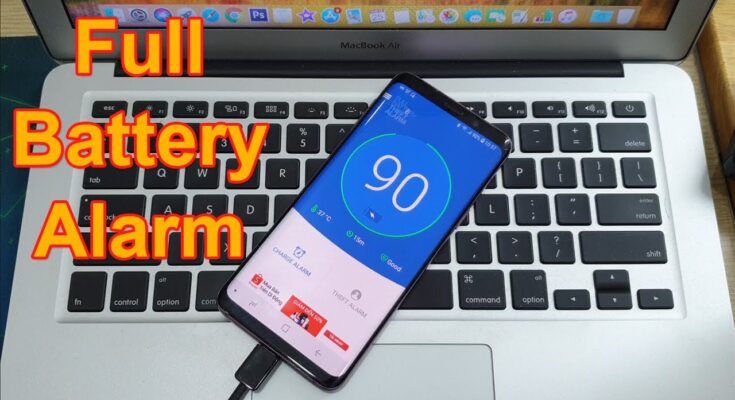Introduction: The Importance of Battery Life
Battery life is a crucial aspect of mobile device performance, directly influencing user experience and day-to-day convenience. With smartphones becoming indispensable tools for communication, productivity, and entertainment, managing battery power efficiently ensures uninterrupted usage. Sudden battery depletion can disrupt essential tasks, highlighting the need to monitor power levels effectively.
Sound notifications for battery-related events play an integral role in this context. These alerts serve as proactive reminders for actions such as charging the device or conserving battery. By setting up such notifications, users can avoid potential inconveniences caused by a drained battery, enabling better planning and device longevity.
Specifications
To set up battery sound notifications on an Android device, the operating system must typically be Android 6.0 Marshmallow or newer. Devices should have sufficient storage space to install third-party apps if needed and access to the Google Play Store for downloading compatible notification tools. A functional speaker or connected audio output is essential to ensure sound alerts operate effectively. Location of relevant settings may differ slightly between device manufacturers due to varying Android skins, such as One UI, MIUI, or OxygenOS. Users should also ensure device permissions for notification access are appropriately configured before proceeding.
Optimize Screen Brightness and Timeout Settings
Adjusting screen brightness and timeout settings is crucial for prolonging battery life on Android devices. Excessive brightness drains the battery quickly. Users should enable the adaptive brightness feature, which automatically adjusts the screen’s illumination based on surrounding light conditions. Alternatively, manually set a lower brightness level in the device’s settings for consistent energy conservation.
Shortening the screen timeout duration also minimizes battery usage. Navigate to the display settings to reduce how long the screen stays awake when idle. Ideal timeout values, such as 15 or 30 seconds, balance convenience and energy efficiency, helping the device last longer between charges.
Use Battery Saver Mode Effectively
Activating Battery Saver Mode can significantly extend the runtime of your Android device, especially when battery levels are low. This mode minimizes background activities by restricting app updates, syncing, and certain visual effects. Users should enable this feature manually or set it to activate automatically at a specific battery percentage.
Key strategies include:
- Adjusting the activation percentage threshold in the settings for earlier performance optimization.
- Temporarily disabling non-essential and high power-consumption apps during this mode.
- Monitoring notifications, ensuring Battery Saver Mode does not interfere with critical alerts like battery sound notifications.
Properly using this mode prolongs device usability without compromising functionality.
Identify and Manage Power-Hungry Apps
Monitoring and managing power-hungry apps is crucial to extend battery life and optimize device performance. Android devices offer built-in tools to identify apps that consume excessive power. Navigate to Settings > Battery to view a detailed breakdown of battery usage by apps and services. Prioritize attention to apps consuming the most energy over short periods.
To manage such apps effectively:
- Limit Background Activity: Disable background activity for non-essential apps.
- Update or Uninstall: Ensure apps are up to date or consider uninstalling poorly optimized ones.
- Enable Battery Saver: Use battery saver modes to restrict resource usage for demanding apps.
Regularly reviewing power usage metrics helps maintain consistent device performance.
Keep Your Software and Apps Updated
Regular updates to the Android operating system and your apps are essential for optimal functionality, including sound notifications for battery alerts. Updates often include important bug fixes, security enhancements, and feature improvements that may directly impact how notifications behave. Failing to update could result in compatibility issues that prevent certain functionalities, such as battery sound notifications, from working as intended.
To ensure your device stays updated:
- Check for system updates by navigating to Settings > Software Update.
- Update your apps by visiting the Google Play Store, tapping on your profile icon, and selecting Manage apps & device.
Periodic updates maintain proper system stability and performance.
Leverage Adaptive Battery and Adaptive Brightness
Android devices feature Adaptive Battery and Adaptive Brightness settings designed to optimize power usage and extend battery life effectively. Adaptive Battery utilizes machine learning to understand app usage patterns, limiting the devices’ resources for rarely used apps. Users can access this feature by navigating to the Settings, selecting Battery, and enabling Adaptive Battery under advanced settings.
Similarly, Adaptive Brightness intuitively adjusts screen brightness based on ambient lighting and usage habits. This not only enhances user experience but also reduces battery consumption significantly. To enable it, users can go to Settings, select Display, and toggle Adaptive Brightness on. Combined, both features maximize overall efficiency efficiently.
Use Dark Mode to Your Advantage
Activating Dark Mode on your Android device can significantly extend battery life, especially for devices featuring OLED or AMOLED screens. These display types consume less energy when rendering dark or black colors because individual pixels turn off completely to produce black, saving power.
To enable Dark Mode:
- Navigate to the Settings menu.
- Select Display or Appearance, depending on your device.
- Toggle the Dark Mode or Dark Theme option.
Dark Mode reduces screen brightness and minimizes strain on the eyes during nighttime use. Combining it with sound notifications for battery alerts enhances user experience while promoting effective power management across the system.
Control Background Data Usage
Managing background data usage is essential for optimizing battery performance and enhancing device efficiency. To control apps that may excessively use data in the background:
- Navigate to Settings and tap on Network & Internet or Connections based on the device model.
- Select Data Usage to view apps consuming mobile or Wi-Fi data.
- Tap on an app to access detailed data usage analytics.
- Toggle Restrict Background Data to limit its data access while running in the background.
- Opt for Battery Saver Mode, which further restricts unnecessary syncing and activity.
These actions can contribute significantly to reducing battery drain, especially when combined with careful notification and app settings adjustments.
Proper Charging Habits for Longevity
Adopting proper charging habits can significantly enhance the lifespan of an Android device’s battery. Users should avoid allowing battery levels to drop below 20% frequently, as this can cause wear over time. Similarly, keeping the battery consistently above 80% is less ideal for long-term health.
- It is recommended to use only certified chargers compatible with the device.
- Avoid overcharging by unplugging the charger after reaching 100%.
- Charge in a cool environment, as excessive heat can degrade battery performance.
- Enable battery optimization features available on Android for better efficiency.
Maintaining these practices helps balance performance and longevity for daily use.
Utilize Battery Monitoring and Analysis Tools
Battery monitoring and analysis tools provide insights into the performance and usage patterns of your Android device’s battery. These tools help identify the factors draining battery life and allow better management of battery health. Users can explore built-in system tools, such as Android’s battery settings, or third-party apps tailored for advanced diagnostics.
- Built-In Tools: Navigate to your device’s battery settings to check app-specific battery consumption and set usage restrictions.
- Third-Party Applications: Try apps like AccuBattery or GSam Battery Monitor for detailed data on charge cycles, health metrics, and consumption trends.
- Real-Time Tracking: Use tools that offer real-time notifications, so you can enable sound alerts for critical battery levels.
Implementing these tools ensures timely notifications are paired with actionable insights.
Disable Unnecessary Connectivity Options
Disabling unused connectivity options can help conserve battery life, ensuring reliable sound notifications without interruptions. Features like Bluetooth, Wi-Fi, and mobile hotspots often run in the background, consuming significant power.
To streamline this, users should assess active connections and disable those not in immediate use. For instance, if Wi-Fi is unavailable, turning it off prevents continuous network scans. Likewise, Bluetooth should remain off unless syncing with devices.
Airplane mode can also be activated during periods of no connectivity needs while still allowing alarms or sound notifications to function. Regularly optimizing these settings ensures optimal power management for uninterrupted alerts.
Advanced Tips: Root for Enhanced Control
For users with rooted Android devices, battery sound notifications can be customized at a deeper level, offering more control and precision. Root access allows modifications to system files, unlocking advanced options for creating unique audio cues. Users can directly modify the system/media/audio folder to replace or add custom notification sounds. They may also use root-enabled automation apps, such as Tasker or MacroDroid, to create complex profiles triggered by specific battery levels, charging states, or temperature thresholds.
Additionally, some power-management modules, like Magisk modules, provide extended capabilities for optimizing and personalizing battery notifications. Users are advised to proceed with caution and create backups before making changes.
Conclusion: Maximizing Your Android Battery Life
To enhance your Android device's battery performance, users must adopt consistent habits that align with efficient power usage. Regularly calibrate battery sound notifications to stay alert about charging levels. Minimize unnecessary app activity by disabling those running in the background. Adjust screen brightness, enabling "Adaptive Brightness," to reduce power consumption effectively.
Implement battery saver mode during low charge scenarios to optimize energy usage. Periodically assess permissions for apps known for high resource consumption. Limit use of animated wallpapers and extensive GPS tracking unless necessary. Review and update device firmware for enhanced power management features. These practices contribute to extending battery longevity while maintaining optimal device performance.



